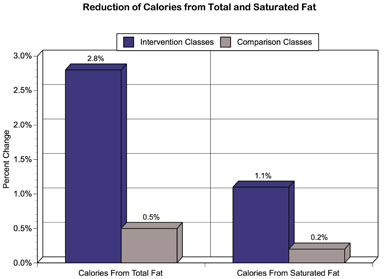Program Synopsis
Designed to improve dietary habits among women and their families, this community-based intervention consists of a classroom component with lessons, small- and large-group activities, discussions, and tasks to build skills in choosing and preparing low-fat foods followed by a 12-week maintenance intervention involving calls or mailings to provide support and encouragement. The study showed reductions in calories from total fats and saturated fats.
Program Highlights
Program Materials
Preview or download materials
Program Scores
The Need
It has been estimated that as many as 90 million or 48 percent of American adults have limited literacy abilities. Literacy is likely to be a significant predictor of poor health and cardiovascular disease outcomes. Low literacy levels are positively correlated with lower education, income, and occupational status, which are significant predictors of cardiovascular disease mortality and risk factors. Few comprehensive nutrition programs for cardiovascular disease risk factor reduction have been developed specifically for adults with low literacy skills despite a growing awareness of the need for such programs.
The Stanford Nutrition Action Program (SNAP) is a classroom-based comprehensive nutrition program designed specifically to address this need. SNAP targets low-fat eating, uses methods and materials tailored for adults with low literacy levels, and incorporates principles of adult learning and social learning theory.
The Program
In 1991, the Stanford Nutrition Action Program was one of eight projects funded under a research initiative issued by the National Heart, Lung, and Blood Institute to develop and test nutrition education methods and materials for English-speaking adults with low literacy skills. SNAP teaches methods of choosing and preparing low-fat foods in ways that will help women and their families reduce their risk of heart attack by lowering fat intake.
SNAP consists of a 6-week classroom-based intervention (90 minutes per session) followed by a 12-week maintenance intervention. Classroom lessons cover the major sources of dietary fat, the food guide pyramid, food label reading, and low-fat eating when away from home. Central to the lessons is the link between low-fat eating and the prevention of heart disease. Participants engage in small- and large-group activities, interactive discussions, skill-building tasks, food tastings, and demonstrations. Many practical shopping and cooking tips are included. Lessons are made culturally appropriate for the large number of Hispanic women who attend classes. The 12-week maintenance intervention includes participant contact by telephone or by mail every 2 weeks, and provides support and encouragement to continue a low-fat diet.
Time Required
Lesson preparations should start 3-4 weeks in advance of the course. Because SNAP is a highly interactive and multi-component curriculum, teaching aids such as visuals and demonstration materials should be purchased and created prior to teaching the first lesson. An extra day or two for preparing such materials is usually needed. After finishing the initial advance preparation, additional pre-class time should be needed only to prepare food for tasting and to review the lessons prior to teaching.
Intended Audience
The program is designed for an ethnically diverse population of English-speaking adults with low literacy skills, with a particular focus on Mexican-American women.
Suitable Settings
The intervention is suitable for implementation in community sites where group or classroom-based activities are conducted (e.g., vocational training or general education sites). The materials can also be distributed through other community-based programs, such as library literacy education programs, services for the poor and homeless, and preschool parenting classes.
Required Resources
The Stanford Nutrition Action Program materials include the It's a Snap! curriculum binder, posters, and index cards.
About the Study
A randomized design was used to compare the effectiveness of two classroom-based nutrition curricula on lowering dietary fat intake. Twenty-four vocational training and general education degree classes were matched in pairs for class size and type of class. One of each pair was allocated randomly to receive either the newly developed curriculum that focused primarily on lowering dietary fat intake (SNAP) or an existing curriculum, also designed for low-income populations, which focused on general nutrition. Participants of the study were primarily young, Hispanic women (58%) who were born in the United States and of Mexican heritage. Additionally, 20% were White, 10% were Asian, and 12% were classified as "Other".
Key Findings
Following the 6-week intervention, SNAP classes had significant reductions in:
- the percentages of calories from total fat (SNAP baseline: 37.1, follow-up: 34.3; general nutrition baseline: 36.4, follow-up: 35.9) and
- significant reductions in calories from saturated fat (SNAP baseline: 13.3, follow-up: 12.2; general nutrition baseline: 13.0, follow-up: 12.8).
Effects were maintained for 12 weeks post-intervention.

Following the 6-week intervention, SNAP classes demonstrated significantly greater improvements than general nutrition classes.
Percent correct on nutrition knowledge scores (SNAP baseline: 57.0, follow-up: 66.6; general nutrition baseline: 55.8, follow-up: 57.7); Mean attitudes toward eating a low-fat diet (SNAP baseline: 3.5, follow-up: 3.8; general nutrition baseline: 3.5, follow-up: 3.6) (scale 1-5); Mean self-efficacy for achieving a low-fat diet (SNAP baseline: 3.8, follow-up: 4.1; general nutrition baseline: 3.8, follow-up: 3.9) (scale 1-5).
Publications
Albright, C. L. Bruce, B. Howard-Pitney, B. Winkleby, M. A. & Fortmann, S. P. (1997). Development of a curriculum to lower dietary fat intake in a multiethnic population with low literacy skills. Journal of Nutrition Education, 28, 215-223.


